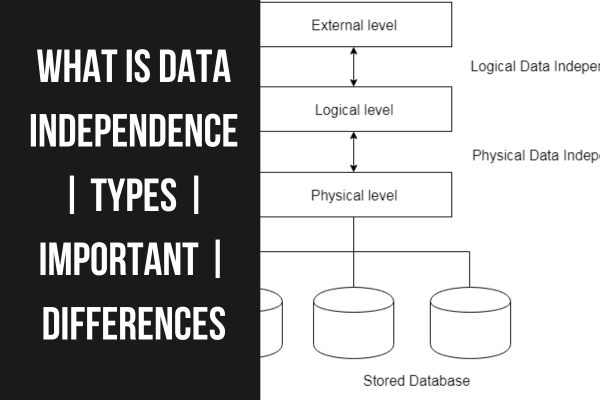Data independence is a concept that refers to the ability of a database system to operate independently of the application programs that use it. This means that changes made to the database structure or data storage methods will not affect the application programs that use it. In other words, data independence allows for the separation of concerns between the data and the programs that use it, which promotes modularity, scalability, and flexibility in software systems.
In this article, we will explore what data independence is, why it is important, and how it can be achieved in modern database systems.
What is Data Independence?
Data independence is the ability of a database system to insulate the application programs from changes made to the data storage structures or data access methods.
There Are Two Types of Data Independence:
Physical Data Independence: Physical data independence refers to the ability of a database system to modify the physical storage structure of the data without affecting the application programs that use it. For example, if a database administrator changes the storage media from a hard disk to a solid-state drive, the application programs should continue to function as expected, without needing any modifications.
Logical Data Independence: Logical data independence refers to the ability of a database system to modify the logical structure of the data without affecting the application programs that use it. For example, if a database administrator adds a new field to a database table, the application programs should be able to access the new field without needing any modifications.
Why is Data Independence Important?
Data independence is important for several reasons, including:
Flexibility: Data independence allows for the separation of concerns between the data and the programs that use it, which promotes modularity, scalability, and flexibility in software systems. This means that changes can be made to the data storage structure or access methods without affecting the application programs that use it, which makes it easier to adapt to changing business requirements.
Maintainability: Data independence makes it easier to maintain and modify software systems over time. Because changes to the data storage structure or access methods do not affect the application programs that use it, it is easier to make modifications to the database without affecting the application code.
Performance: Data independence can also improve the performance of software systems. Because the database can be optimized independently of the application programs that use it, it is possible to tune the database for optimal performance without affecting the application code.
How can Data Independence be Achieved?
Data independence can be achieved through the use of modern database systems that provide abstraction layers between the data and the application programs that use it. These abstraction layers allow for the separation of concerns between the data storage structure and access methods, and the application programs that use it.
There are several approaches to achieving data independence, including:
Database Management Systems: Modern database management systems, such as MySQL, Oracle, and Microsoft SQL Server, provide abstraction layers between the data and the application programs that use it. These systems allow for the separation of concerns between the data storage structure and access methods, and the application programs that use it.
Object-Relational Mapping (ORM): ORM is a programming technique that maps database objects to programming language objects. ORM provides an abstraction layer between the database and the application programs that use it, which allows for the separation of concerns between the data storage structure and access methods, and the application programs that use it.
Service-Oriented Architecture (SOA): SOA is an architectural style that promotes the separation of concerns between different components of a software system. In a SOA, the data storage structure and access methods are encapsulated within a service, which provides an abstraction layer between the data and the application programs that use it.
Differences between Physical and Logical Data Independence
The main difference between physical and logical data independence is the type of changes that can be made to the database system without affecting the applications that use it.
Physical data independence allows for changes to the physical storage structure of the database system, such as upgrading hardware or storage media, without affecting the applications that use the data. Logical data independence, on the other hand, allows for changes to the logical structure of the database system, such as adding or removing tables or modifying data types, without affecting the applications that use the data.
Another difference is the level of abstraction that each type of data independence provides. Physical data independence provides a lower level of abstraction than logical data independence, as it deals with the physical storage components of the database system. Logical data independence, on the other hand, provides a higher level of abstraction, as it deals with the logical structure of the data.
Finally, physical data independence is typically more difficult to achieve than logical data independence. This is because changes to the physical storage components of the database system require a higher level of technical expertise than changes to the logical structure of the data.
Conclusion
In conclusion, physical and logical data independence are both important concepts in modern database systems. Physical data independence allows for changes to the physical storage structure of the database system, while logical data independence allows for changes to the logical structure of the data. Both types of data independence are important for promoting modularity, scalability
Also Read-





Leave a Reply